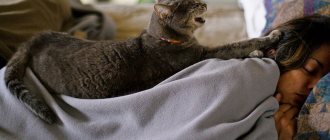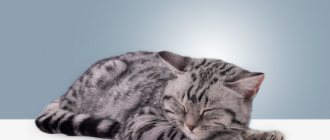Guess what is the fundamental difference between the main pets - cats and dogs? Yes, the fact is that cats are picky about absolutely everything. If they don’t like something, they will immediately show their displeasure in every available way. In extreme cases, they will completely ignore you. These properties of cats are manifested in everything - in everyday life, in relation to food, and in many other ways. A cat can easily take offense at its owner even for unsuccessful, in its opinion, caresses!
In general, cats are unique creatures. No two cats are alike. Therefore, if you are waiting for advice from us on how to stroke them correctly, then you are in vain - what gives pleasure to one animal may be unpleasant to another. But we will try to give you some universal advice of a different kind - how to prevent you from making gross mistakes in such a delicate and responsible issue.
Don't stroke your cat against the grain. You should never do this even as a joke. Almost all cats cannot tolerate such treatment. The most patient of them will probably not scratch you for such tactlessness. “Stroke the fur” - this saying is specifically about cats!
Strictly speaking, a cat’s negative reaction, or rather its degree, depends on the length of its fur. With a short-haired animal everything is clear and understandable. There may be some exceptions with long-haired pets - they may respond more favorably to a soft “massage” and stroking in both directions.
With dogs everything is different - they will be grateful to you for any kind of attention. But cats will demand from you not only attention, but also reverence. God forbid you work with a cat according to the “dog” canons.
Everything should be built according to a stepwise principle. Did you suddenly want to pet your cat, did you find it, squeeze it in your arms and start petting it? In vain! Cats love ceremonies. First, you should assess the degree of her readiness for tenderness. Secondly, cats like to say “hi” first by gently nuzzling them with their nose. Finally, thirdly. Have you noticed that just as you are preparing to pat your pet on the head, he dodges and tries to sniff your fingers? The fact is that at this moment the cat decides whether it is ready to respond to your caresses and relax from your gentle touches. Take this circumstance into account when grabbing a cat, do not miss a single link in this chain, evaluate how calm your pet feels.
You know how cats greet each other on the street, touching their noses - this ritual signifies greeting, mutual affection, and a set of certain smells that carry important information. Behave the same way with your cat! Reach out your hand, let your pet sniff and explore, and wait to see what happens next. You will understand everything yourself!
Tummy: yes or no? Many cat owners are attracted by their warm, soft and fluffy belly, and are simply tempted to stroke and cuddle it! But not every cat will let you do this; some animals express their protest in violent, even aggressive forms. Our advice: do not impose, do not go against the will of the cat. If your pet belongs to the minority that loves stroking in this tender and very vulnerable place, she will invite you to do it.
The problem here may be this. If a cat opens its tummy to you, this is the highest sign of trust on its part, and if you neglect and do not stroke it, such a gesture can even be regarded as betrayal.
Some cats may allow you to stroke their tummy a couple of times before they begin to actively show their displeasure. In this case, stop trying immediately and do not anger your pet!
A little about hyperstimulation. Don't be put off by the tricky word in the subtitle. To put it a little more simply, do not pet your cat to the point of complete exhaustion. Many cats willingly respond to the caresses of their owners, they find them very pleasant, but at one certain moment they seem to reach a boiling point, a point when all your caresses, instead of pleasure, will give off painful sensations. In other words, the animal will become overexcited and can easily either scratch or even injure you while trying to escape.
Knowing such tendencies in your pet, carefully watch him in moments of tenderness. Try not to lead to such moments.
Avoid rough caresses. We noted above that each cat has its own preferences. Some cats enjoy gentle, light touches and strokes. Others don't mind if you squeeze them heartily. But try not to overstep the limits of reason, do not put pressure on the animal, as they say, with all your might. Cats are built a little differently than dogs; they are gentle and vulnerable creatures. Never use force and everything will be fine!
Funny and educational stories about your pets -
subscribe to our channel!
Where are dogs' belly buttons?
How to make friends between a cat and a dog? Why does a hedgehog laugh? The entire encyclopedia about animals is on our website.
What diseases can a cat transmit to humans?
Most often, cats transmit the following diseases:
- ringworm;
- helminthiases;
- toxoplasmosis;
- cat scratch disease.
In cats, ringworm is usually detected at the stage when bald patches have already appeared. At this point, the expectant mother may already be infected. The disease is often transmitted to children after childbirth. This is not the most dangerous form, however, in some cases, in the presence of background pathologies, due to increased load on internal organs, there is a risk of developmental abnormalities in the fetus.
Helminthiasis is an infection with worms. Even domestic cats can have parasites. Animals often become infected after eating raw meat. Sometimes the owners themselves bring worm larvae from the street on their soles. In most cases, helminthiasis does not threaten the health of the mother and child, but the drugs used to treat the disease are toxic. In addition, with severe infection, many decay products enter the bloodstream and poisoning occurs.
Toxoplasmosis is a parasitic disease. It can either occur in the form of a mild respiratory infection or cause developmental abnormalities in the child. Infection of the fetus in the first trimester often leads to miscarriage. In later stages, premature birth is often observed. It is difficult to distinguish toxoplasmosis from ARVI on your own, so if the temperature rises to +37.2 °C or higher, enlarged lymph nodes and headaches and muscle pain appear, you should consult a doctor.
In the case of cat scratch disease, infection occurs through scratches and bites. Pathology appears in the form of a red spot 3–10 days after injury. After 2–3 weeks, the lymph nodes enlarge. Mild malaise and muscle pain may occur. Sometimes the disease leads to fetal hypoxia, and even less often - to the threat of premature birth. Fortunately, in most cases the pathology is mild.
The spots may be raised, but usually do not cause discomfort
Why does a cat purr like a tractor?
This sound is an integral feature of all purrs, which means gratitude to the owner for tasty food and affection. The cat purrs like a tractor
when he shows his tenderness and love.
for cat
to purr while feeding or licking their kittens.
Interesting materials:
Where can I get a medical examination for my license? Where can I get a driver's license test? Where can I take a medical examination for my license? Where can I get a medical certificate to replace my license? Where can I get a certificate for my license? Where can I restore my rights if lost? Where can I restore my rights? Where in Rus' was there no serfdom? Where can I find copyright-free music for YouTube? Where can I get a medical certificate for a driver's license?
What is cat fur made of?
In order to correctly understand what exactly a cat experiences when it is scratched against its fur, you need to at least know what it consists of. The coat of cats is heterogeneous and includes:
- guard hairs;
- cover hairs, to the touch they are much harsher than guard hairs, despite the fact that they are their variety;
- undercoat (some breeds lack it).
The guard hairs are pigmented, so they determine the color of the cat's coat. At the base, such hair is very thick, but closer to the ends it becomes thinner.
The undercoat, on the other hand, includes very fine downy hair that surrounds the guard hairs. It retains heat well and slightly protects the animal from getting slightly wet.
How not to pet cats
To keep the animal happy, when ironing, do not forget about the following rules:
- Do not iron against the grain - this causes discomfort.
- Avoid too rough and sudden movements. Any touches to the cat should be soft and gentle.
- Most cats do not like to have their tummy touched, as this is the most unprotected part of the body: they can only allow a person they completely trust to touch it. Even if they lie down next to you on their back, this is not a reason to stroke their belly - it’s better to scratch under their chin and stroke their chest.
If all these rules are followed, you can hear a contented, grateful purr.
Pleasant areas for stroking
Head and back of the head
The favorite place to touch is the head, in particular, if you scratch behind the ear, you can hear a purr.
Almost all cats love affectionate touches on the head. Kittens remember that this is where their mother licked them. These pleasant sensations remain in the subconscious for life. Sitting comfortably on your hands or knees, the cutie will gratefully accept the love of his owners if he is scratched behind the ears and the back of his head. The cheeks are especially sensitive - the area behind the mustache below the eyes. By lightly patting this area, you can hear purring.
Breast and neck
With gentle movements of your fingers, moving from the chin to the neck, you can observe how the cat is pleased, and he stretches his neck forward, submitting his palms and squinting his eyes. These areas are located in such a way that it is difficult for a cat to comb them out on his own, so help is simply necessary here. He will not refuse several repetitions of the slow combing procedure, hinting at continuation.
Back and sides
Wide, gentle movements of the palm from the head to the base of the tail along the spine will demonstrate care. After all, such a massage relieves muscle spasms and stress on the back. Arching the body and rubbing the forehead on the hand encourages the owner to repeat what the cat liked. The paws remain controversial areas. Here the reaction may be different. It must be carefully clarified and conclusions drawn.
What if my cat doesn't like being petted?
Let's remember the survey results. There are few such cats, but they still exist. And these are not necessarily street cats. Some indoor cats that were born and raised indoors may not like being stroked. These are usually shy animals that still prefer to keep their distance.
And this does not mean that the cat does not love you. Just let her determine the type of interaction that is convenient for her.
Respect your cat's personal boundaries, and perhaps over time she will begin to allow you more.
A similar sign
Can pregnant women pet cats? To answer this question, we need to consider several points of view. Some associate the ban with superstitions, others justify it as a possible danger to the baby and mother. Scientists have found that even well-groomed pets can transmit diseases. Let's find out what negligence can lead to.
Precautionary measures
To avoid infection, follow these rules:
- Pet only domestic cats. It is strongly recommended to avoid contact with other animals.
- Keep your cat dewormed and vaccinated on time to reduce the risk of your cat becoming infected.
- Do not feed your pet raw meat, eggs or milk.
- Don't let your cat go outside.
- Ask other family members to clean out litter trays.
A cat is not only a cute pet, but also a dangerous predator and a potential carrier of diseases. A pregnant woman is responsible for two lives at once: her own and her child. For this reason, it is better to refrain from contact with street animals, and to carefully treat your pets for parasites and regularly vaccinate them.
Do cats like having their bellies scratched?
Has it ever happened to you that you start petting a cat, it falls to the floor and turns its belly towards you. You want to scratch it too, but in response the animal begins to bite and scratch. Why? What did you do wrong?
Of course, there are exceptions, but many veterinarians advise not to touch their belly. This makes sense when you consider how vulnerable this area is to injury. During a fight, a cat must protect its belly at all costs. So she can react sharply even to the owner’s touch.
Hair growth direction
Guard and integumentary hairs grow in a strictly defined direction. Thanks to this, the hairs fit tightly to each other and to the skin. Such orderliness is necessary so that heat exchange is not disturbed, and the cat is at least minimally protected not only from cold, but also from humidity.
If you stroke a cat against the grain, the guard hairs will rise. And since each hair is surrounded by many nerve endings, such stroking will invariably cause irritation and even unpleasant pain. Downy hair has no direction of growth, but guard hair is very sensitive.
We also recommend reading:
The largest dog breeds What is domestication in animal husbandry Why you should get a cat: reasons voiced by scientists Euthanasia of animals
Remember that cats never lick small kittens against the grain. Every animal remembers moments when its mother took care of the cleanliness of its coat. So the owner’s caresses remind the pet of childhood. Therefore, try to always stroke your cat only in the direction of hair growth, since this is the only type of stroking that she enjoys.
Wool is easily electrified
On the outside, the guard hairs are covered with special scales made of keratin; the more tightly they adhere to the hairs, the more shiny and beautiful the pet’s fur is. What happens when you stroke a cat against the grain? The keratin scales move and rub against each other, causing a small electrical charge to form between the hairs. The cat feels this, of course, it is not in danger of a fatal electric shock, but it still becomes quite unpleasant for it. If, after the fur has become electrified, you touch your pet again, a weak electrical charge will hit both you and him. So stroking against the grain brings significant harm not only to the cat, but also to its owner.
What should you do if your pet's fur still becomes electrified, even if you never stroke it against the grain? Most often this happens for three reasons:
- due to low air humidity;
- due to frequent bathing, which dries out the animal’s fur, or due to incorrectly selected shampoo;
- due to poor quality nutrition.
But in any case, strong electrification of the pet’s fur and loss of its shine is a reason to visit the veterinarian. Only he will be able to determine the cause of such symptoms and prescribe the necessary treatment to eliminate them. Remember that dull fur may indicate the presence of diseases, which only a specialist can help you cope with.
A similar sign
All people, even those who do not have a cat as a pet, know the rule: “You cannot stroke a cat against its grain!” And for those who have a pet, you can check it in practice - it will be unpleasant for the animal. This is due to several reasons.
Why a cat can be dangerous for a pregnant woman
First of all, a cat can pose a threat due to aggression. During pregnancy, even minor stress can sometimes lead to the death of the child. Cats, having noticed potential danger, most often prefer to retreat, but this does not always happen. For example, a pet protecting kittens can even attack its owners. If you know your own pet and its habits, then you cannot be sure about a stranger or a street cat. When attacked, the predator can cause serious injuries and even cause bleeding.
Cats may curl their ears and twitch their tail before attacking.
Another possible threat is the risk of infection. Some diseases can be transmitted from cats to humans. During pregnancy, any infection poses a greater threat, since in this case the list of available drugs is reduced. Due to the toxic effect, women cannot take the most effective antibiotics and anthelmintics.
Mystical reasons
If you stroke a cat against the grain in the dark, you will notice small blue lights on it. This way you can see static electricity with your own eyes. Previously, people knew nothing about it, so they thought it was a manifestation of black magic. And since the cat has been considered a mystical animal since ancient times, it was strictly forbidden to scratch it against its grain, so as not to invite trouble upon oneself. Our ancestors can be understood, because the eyes of a cat that glow in the dark can scare anyone. And in combination with sparkling fur, they look really unusual, so this phenomenon could well be mistaken for real witchcraft.
As you can see, there are several reasons why it is better not to stroke a cat against its grain. Remember that such stroking is simply unpleasant for your cat, and you still shouldn’t deliberately cause discomfort to her.











